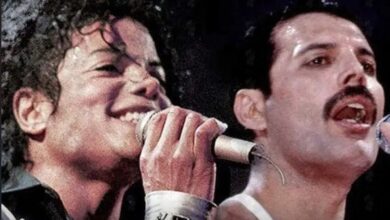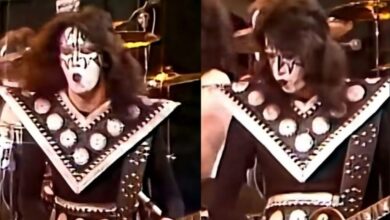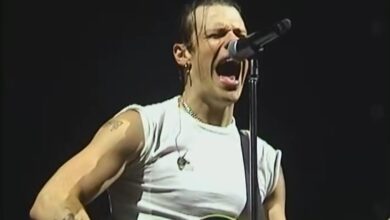The Sound of Silence Reimagined: A Modern Powerhouse Performance
The opening moments of Dan Vasc’s “The Sound of Silence” strike you not with volume, but with restraint. Instead of diving headfirst into the kind of operatic intensity many expect from his metal-infused covers, he begins with an atmosphere of quiet patience. That decision alone sets the stage for something bigger. It’s a nod to the song’s original folk roots, while also serving as an artistic statement: silence itself can be the most powerful instrument. By letting the track breathe, he primes the audience for the eventual eruption, turning the listening experience into a cinematic journey rather than a simple performance.
Of course, “The Sound of Silence” carries with it decades of weight. First recorded by Simon & Garfunkel in the 1960s, the song has evolved across genres, from coffeehouse ballad to arena-sized spectacle. Disturbed’s 2015 version proved that the song could be reimagined with darker, symphonic textures, bringing it back into the mainstream and onto playlists of a younger generation. When Dan Vasc decided to tackle it, the comparisons were inevitable. Yet his rendition doesn’t simply mimic what came before—it builds on that lineage while adding a unique layer of theatricality, making the song his own.
What makes Vasc’s version stand out is his mastery of dynamics. He knows when to pull back and when to unleash, creating a tension-and-release arc that feels almost like the structure of a film. The opening lines are delivered softly, almost conversationally, giving the listener a sense of intimacy. As the arrangement expands—piano, strings, and eventually thunderous percussion—the song transforms into something sweeping and grand. By the time the climactic moments arrive, the contrast between beginning and end makes the crescendo feel seismic, like a storm that’s been slowly gathering in the distance before breaking overhead.
Vocally, Dan Vasc demonstrates why his covers reach millions of listeners worldwide. His control over both the delicate and the explosive is rare. In the lower register, his voice carries warmth and clarity, anchoring the quiet verses with sincerity. When the song demands power, however, he doesn’t simply shout—he broadens his tone, filling the space with resonance and grit. It’s that ability to shift from storyteller to powerhouse vocalist, without losing emotional honesty, that keeps audiences glued to every phrase. His technique ensures that each lyric remains intelligible, even when wrapped in symphonic layers.
One of the most impressive aspects of this cover is its arrangement. Unlike stripped-down acoustic versions that rely solely on vocal emotion, Vasc embraces a cinematic scale. The orchestration feels meticulously crafted: pianos echo like distant bells, strings surge in waves, and drums arrive like thunder rolling across a wide-open sky. The production doesn’t overwhelm the vocals; instead, it supports and magnifies them. Each instrument plays a role in building the atmosphere, leading the listener deeper into the unfolding drama. The result is not just a song—it’s a full-bodied soundscape that commands attention.
The video presentation complements this sonic grandeur by keeping things visually focused. There’s no excessive spectacle, no flashing edits or unnecessary distractions. The camera lingers on the performance itself, inviting viewers to experience the emotion directly through the music. In an age when viral content often relies on visual gimmicks, Vasc’s decision to keep the imagery minimal feels bold. It signals confidence: that the song, the voice, and the arrangement alone are enough to captivate. And judging by the response from his audience, that confidence was more than justified.
For longtime fans of “The Sound of Silence,” Vasc’s rendition offers a reminder of why the song has endured for so long. Its themes—alienation, communication breakdown, the haunting sense of being unheard—resonate just as strongly today as they did in the 1960s. Vasc channels that timeless relevance, using his vocal and instrumental arsenal to frame the message in a way that modern audiences can feel viscerally. His interpretation is not just about paying tribute to a classic; it’s about carrying its spirit forward, ensuring the song continues to speak to a new generation.
As the performance builds toward its peak, something fascinating happens. What begins as a quiet reflection gradually morphs into something resembling an anthem. The once-intimate vocal now projects outward, as if addressing a stadium instead of a single listener. The orchestral swells mirror that transformation, and the once-delicate piano now feels like the foundation of a cathedral. It’s here that Vasc’s instincts as a metal vocalist shine brightest—he treats the climax not as an exercise in loudness, but as a moment of revelation. The silence has spoken, and now the sound roars back.
One of the most striking things about this cover is how it appeals to such a wide range of listeners. Folk purists may appreciate the reverence with which the original melody and structure are treated. Rock fans can revel in the muscular build of the arrangement and the vocal intensity that feels stadium-ready. Even fans of film scores will find themselves drawn in by the orchestral sweep that could easily score the climax of a blockbuster. It’s a rare accomplishment: one performance that manages to speak to multiple audiences without diluting its artistic identity.
What also elevates the cover is its emotional honesty. Many singers can mimic intensity, but fewer can convey genuine conviction. When Vasc delivers lines like “silence like a cancer grows,” there’s a palpable weight behind the words. He doesn’t just sing them—he inhabits them. That interpretive authenticity resonates with listeners, sparking emotional reactions that go beyond admiration of vocal technique. This is why so many comments under the video mention goosebumps or tears: the performance doesn’t just sound powerful; it feels lived-in and truthful.
Another layer to this success lies in its shareability. In today’s digital music landscape, songs thrive when they can be clipped, shared, and replayed endlessly on social platforms. Vasc’s version of “The Sound of Silence” has that built-in structure. Its slow build and explosive payoff lend themselves perfectly to reaction videos and highlight reels. Fans know exactly when to point friends to the “wait for this part” moment, and that organic excitement fuels the cover’s viral momentum. It’s music built not just to be heard, but to be experienced communally.
For those familiar with Dan Vasc’s body of work, this cover feels like both a continuation and a milestone. His “Cover-Up” series has become known for reimagining well-loved songs with cinematic scope and metal intensity. But “The Sound of Silence” carries a special gravitas, demanding not just technical skill but interpretive depth. By revisiting it across different releases, Vasc demonstrates an evolving relationship with the song, fine-tuning his delivery and arrangement over time. It’s a testament to his dedication as an artist: he doesn’t just perform a song once and move on, he lives with it, shaping it until it feels fully his own.
From a production standpoint, the mix deserves special attention. Too often, covers in the symphonic-metal realm can become muddy, with instruments competing for space. Here, every element has its lane. The guitars provide a bed of texture without overshadowing the piano. Strings are bright enough to shimmer but not so piercing that they distract. Reverb is applied with precision, creating the illusion of a vast hall while keeping the vocal front and center. It’s a masterclass in how to make a recording feel both massive and intimate at once.
Perhaps the greatest achievement of this cover is how it redefines silence itself. Rather than treating it as an absence, Vasc frames silence as an active force—a character in the performance. The pauses are weighted, the breaths intentional, and the quiet moments feel alive with potential. When the music finally surges, it doesn’t erase the silence; it validates it. The quiet has shaped the storm, and the storm gives meaning to the quiet. It’s a musical embodiment of the song’s message, and that conceptual coherence is what elevates the cover into art.
In the end, Dan Vasc’s “The Sound of Silence” works because it respects the past while boldly inhabiting the present. It is reverent without being restrained, ambitious without being indulgent, and emotional without being manipulative. It demonstrates how a classic can be reborn in new hands, not by erasing what came before, but by amplifying its spirit through fresh perspective. For those who hear it, the cover is more than a reinterpretation—it’s an encounter with a timeless truth, framed in modern sound. That’s why the performance lingers, long after the final note has faded.





